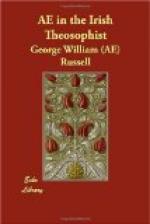“The immortal desire of immortals we saw in their eyes and sighed.”
“Do not heed these forms!” cried Niam. Compare with this from another source: “Flee from the Hall of Learning, it is dangerous in its perfidious beauty. .... Beware, lest dazzled by illusive radiance thy Soul should linger and be caught in its deceptive light. .... It shines from the jewel of the Great Ensnarer.” There are centres in man corresponding to these appearances. They give vision and entrance into a red and dreadful world, where unappeasable desire smites the soul—a dangerous clairvoyence. But in the sphere beyond their power has to be conquered, and here Oisin wars with the giant Fomor. De Dannan and Romorian passed from Eire wrestle still in the invisible world, say the legends. We, too— would-be mystics—are met on the threshold of diviner spheres by terrible forms embodying the sins of a living past when we misused our spiritual powers in old Atlantean days. These forms must be conquered and so Oisin battles with Fomor and releases the power— a princess in the story. This fight with the demon must be fought by everyone who would enter the land of the Gods, whether in conscious occult adventure or half-consciously after death, when the strange alchemist Nature separates the subtile from the gross in the soul in this region which Oisin passes through. Tir-na-noge, the land of Niam, is that region the soul lives in when its grosser energies and desires have been subdued, dominated and brought under the control of light; where the Ray of Beauty kindles and illuminates every form which the imagination conceives, and where every form tends to its archetype. It is a real region which has been approached and described by the poets and sages who, at all times, have endeavoured to express something of the higher realities. It is not distant, but exists in earth as the soul within the body, and may be perceived through and along with the surface forms. In a sense it corresponds with the Tibetan Devachan, and in this region Oisin lives for a hundred years, until desire to see Eire once more arises and he parts from Niam. Nor the details of his return, the drowsy land in which he slumbers; how he fell off the white horse and became an old man with the weariness of his hundreds of years upon him—I must refer the reader to the legends. He will read not alone of Oisin, but of many an old hero, who, hailed by the faery (divine) voice, went away to live in the heart of green hills (to be initiated) or to these strange worlds.
Dear children of Eire, not alone to the past but to today belong such destinies. For if we will we can enter the enchanted land. The Golden Age is all about us, and heroic forms and imperishable love. In that mystic light rolled round our hills and valleys hang deed and memories which yet live and inspire. The Gods have not deserted us. Hearing our call they will return. A new cycle is dawning and the sweetness of the morning twilight is in the air. We can breathe it if we will but awaken from our slumber.




